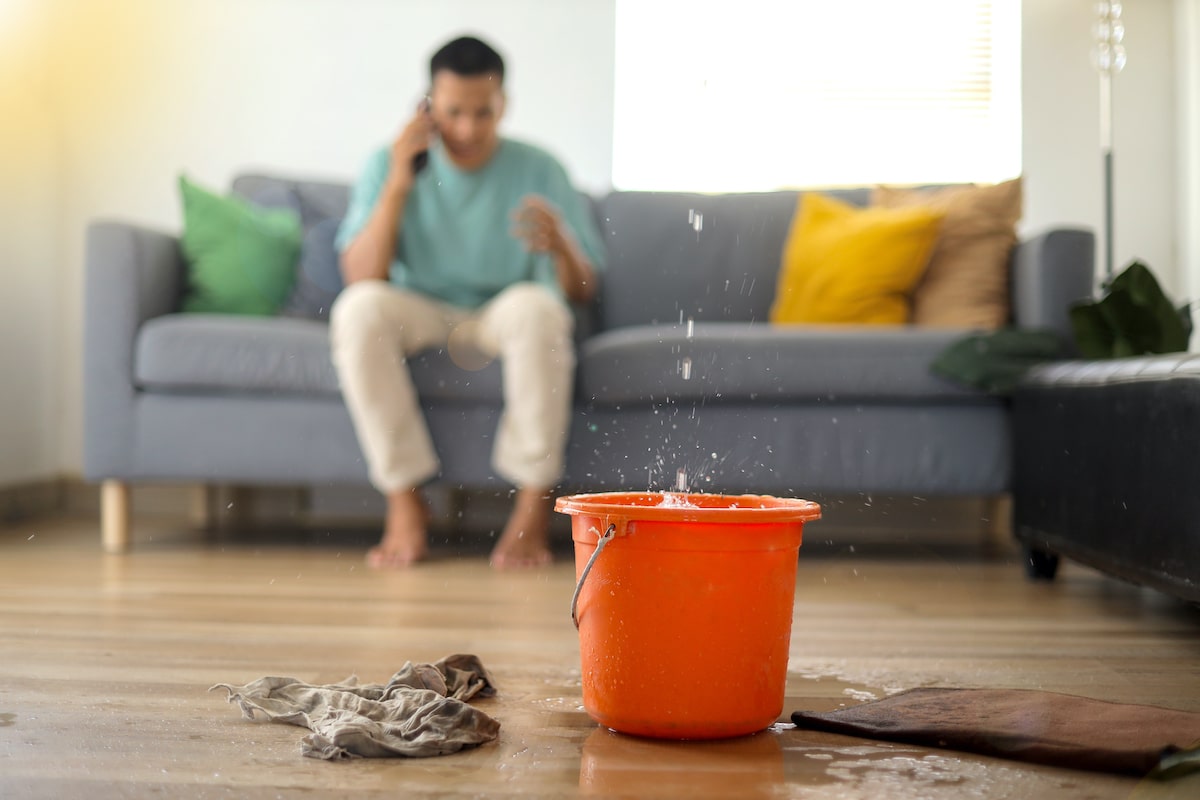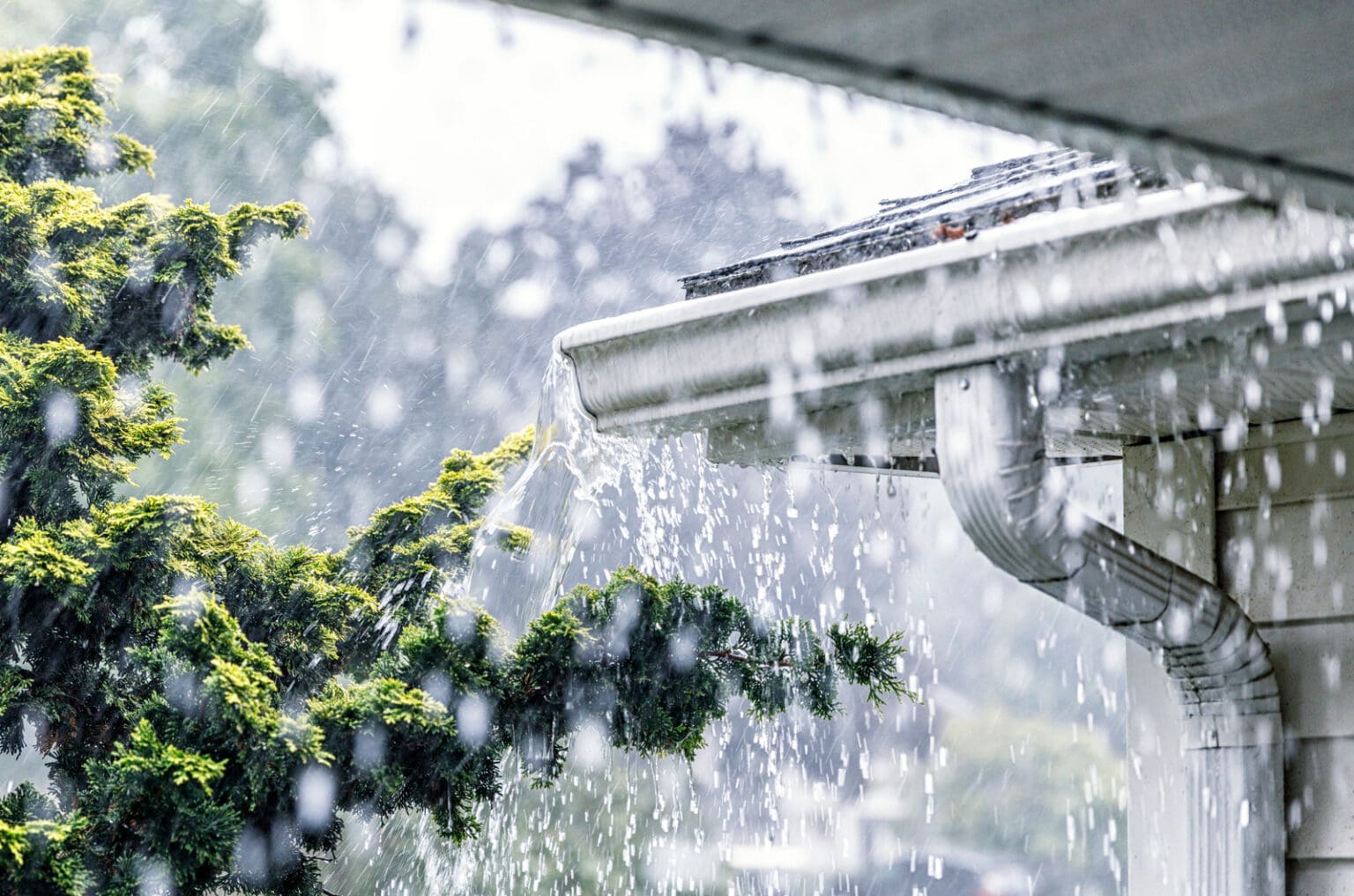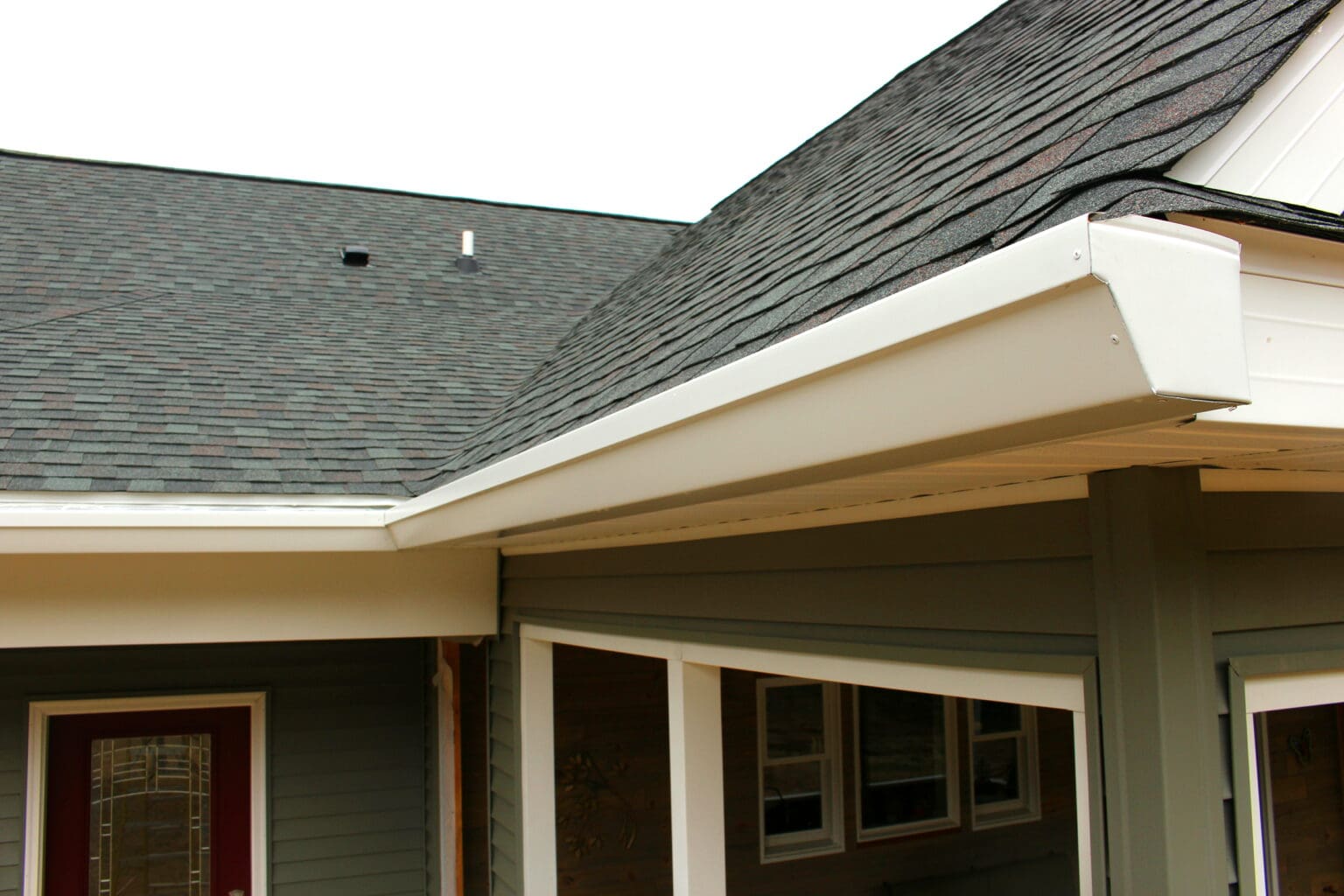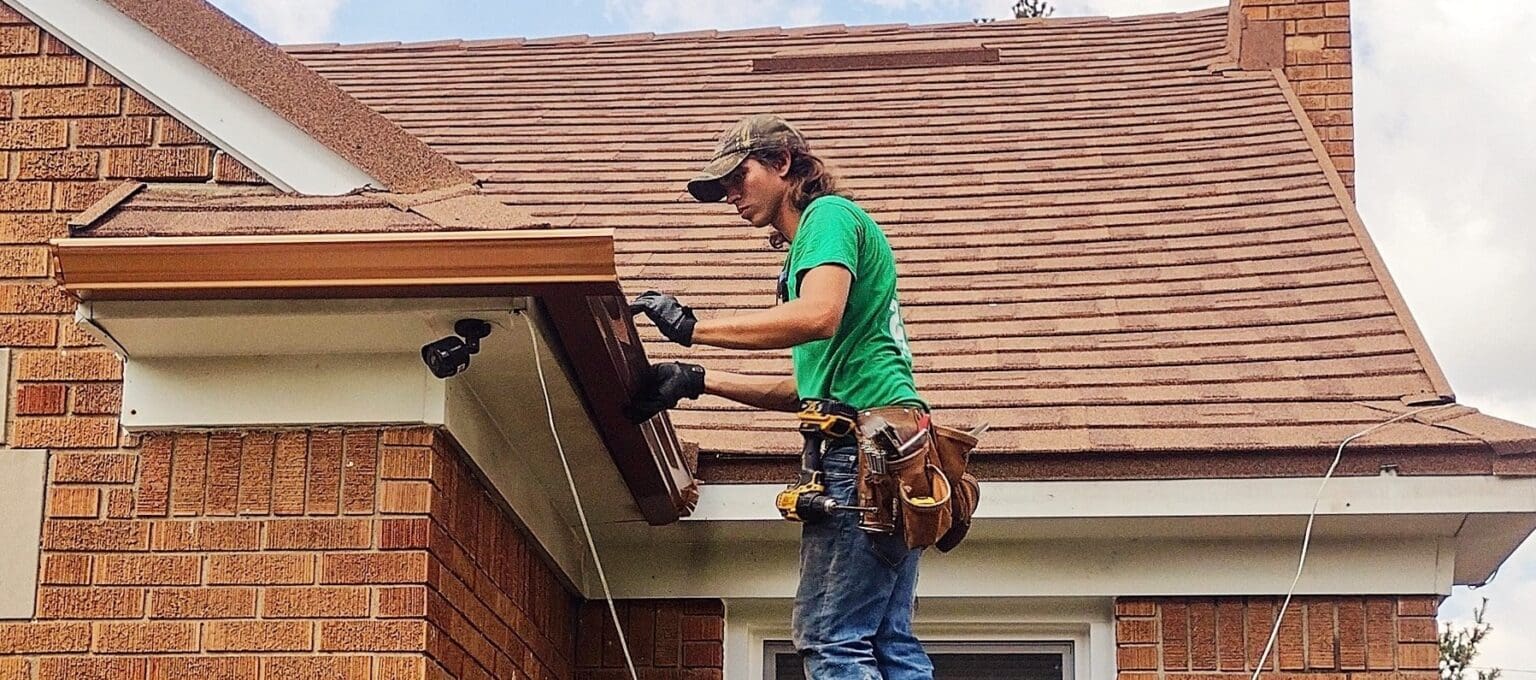REQUEST A FREE QUOTE TODAY
Imagine this: after a heavy rainstorm, you notice pooling water around your home’s foundation, peeling paint on your siding, and your basement has a musty smell. These are not random issues—they’re warning signs of a home without proper gutters. While they may seem like a small detail, gutter systems play a vital role in protecting your property. Skipping this crucial component can lead to serious, expensive consequences.
In this post, we’ll break down the dangers of not having gutters, debunk common myths, and show you how to prevent thousands of dollars in avoidable repairs.

Gutters are more than just decorative trim along your roofline—they are essential to your home’s water management system. When it rains, gutters collect and redirect water away from your home, preventing it from seeping into vulnerable areas. Without gutters, rainwater flows freely off your roof, crashing to the ground and wreaking havoc along the way.

Rainwater collecting around the base of your home can slowly erode the soil, causing the foundation to shift or crack. Over time, this may result in uneven floors, sticking doors, and serious structural instability. Foundation repairs can cost anywhere from $5,000 to over $25,000, depending on the extent of the damage.
Without gutters, water accumulates around the base of your home and eventually seeps into the basement. This can cause mold growth, damage to stored belongings, and ruin flooring or drywall. Even minor leaks can create long-term problems and increase insurance claims.
As rainwater splashes off the roof and onto your walls, it can damage paint, cause wood rot, and create unsightly stains. Over time, this leads to costly siding repairs or replacement. Water exposure also invites insects like termites and carpenter ants that thrive in damp wood.
Rain that isn’t properly channeled away can pool along the edge of the roof, leading to wood rot along fascia boards and roof decking. This not only shortens your roof’s lifespan but may also void warranties on roofing materials that require adequate drainage systems.
Uncontrolled water flow causes trenches, washes away mulch, and drowns your plants. The landscaping you’ve invested in becomes vulnerable to permanent damage, and your yard turns into a muddy mess.
Standing water and saturated surfaces promote mold and mildew growth, which affects your indoor air quality and health. Wet environments are also breeding grounds for mosquitoes, termites, and rodents—all of which bring their own set of problems.
Type of Damage | Severity | Average Cost to Repair/Replace |
Foundation Cracks | Critical | $4,500 – $15,000+ |
Basement Flooding | High | $2,000 – $10,000+ (depending on water damage and mold) |
Wood Rot (Siding/Trim) | Moderate to High | $500 – $5,000 (based on extent) |
Landscape Erosion | Moderate | $500 – $3,000 (regrading, replanting) |
Roof Edge/Fascia Damage | Moderate | $600 – $3,500 |
Mold and Mildew Growth | High (health risk) | $1,000 – $7,000 (mold remediation) |
Peeling Exterior Paint | Low to Moderate | $300 – $1,500 |
Pest Infestation (e.g., termites) | High | $1,500 – $10,000+ (depending on severity) |
In regions with minimal rainfall and mild weather, it’s possible for a home to go without gutters for several months—or even up to a year—without showing immediate damage. However, this doesn’t mean it’s a wise choice. In areas that experience frequent rain, heavy snow, or seasonal storms, the risks multiply quickly. For example, homes in northern climates might remain livable without gutters for a year or two, but serious issues like foundation damage or wood rot can quietly develop long before you notice them.
The bottom line: just because you can go without gutters doesn’t mean you should.
A gutter system costs a fraction of these long-term repairs, making it one of the best return-on-investment improvements for any homeowner.

The condition of your gutters directly affects your home insurance coverage and claim approvals. Insurance providers view gutters as a key part of your home’s defense against water damage. If they’re missing, clogged, or in disrepair, it increases your home’s risk profile—which can lead to higher premiums, coverage exclusions, or even denied claims.
Most policies won’t cover damage that results from neglect. For example, if water seeps into your basement due to overflowing gutters, your insurer may classify it as preventable damage and refuse to pay out. During policy inspections or renewals, insurers may even require gutter repairs before issuing or continuing coverage.
Well-maintained gutters signal responsible homeownership—a factor that can help you maintain lower rates and smoother claims in the future. Regular cleanings, repairs, and documentation of maintenance are smart habits that protect both your home and your wallet.
Overhangs may reduce splashing, but they don’t prevent erosion or foundation damage. Rain still falls close to the base of your home, putting your foundation at risk.
Even in arid climates, a single downpour can cause damage. Snowmelt can also saturate the ground and compromise your home’s structure.
The longer you wait, the more damage you risk. Gutters are easiest and cheapest to install before serious issues occur—not after.
Keeping your gutters in great shape is key to protecting your home and avoiding costly repairs. Here are the most effective ways to maintain your gutters and ensure they work year-round:
Gutters tend to collect leaves, twigs, pollen, and other debris that can quickly cause clogs. Routine cleaning—especially in spring and fall—ensures smooth water flow and prevents overflow. Use gloves, a sturdy ladder, and a small scoop or trowel for best results.
At least once a season, take a walk around your home and inspect the gutter system. Look for rust, loose sections, sagging areas, or visible cracks. Catching small problems early helps avoid major issues later.
Gutter guards are a great way to reduce the amount of debris that enters your system. They can significantly decrease how often you need to clean and help maintain consistent water flow during storms.
Even with clean gutters, blocked downspouts can cause backups. Ensure water flows freely and is being directed well away from your foundation. Consider using splash blocks or extenders to carry water several feet away from your home.
Overhanging branches drop leaves, seeds, and debris directly into gutters. Regular pruning of trees and shrubs around your roofline minimizes buildup and keeps your gutters working efficiently.
Even if your home seems fine without gutters in the short term, hidden damage can slowly accumulate. Soil erosion, basement leaks, and structural cracks can develop over time, especially in climates with moderate to heavy precipitation. Prevention is always more affordable than repair.

Not sure if it’s time to install or repair gutters? Watch for these telltale signs that water isn’t being properly redirected:
These are indicators that your home is suffering from water exposure—damage that gutters are specifically designed to prevent.
Gutters are often overlooked, but their absence can lead to a domino effect of structural issues, health risks, and financial headaches. Whether you’re building a new home or maintaining an older one, installing quality gutters is one of the smartest decisions you can make.
Your home is one of your biggest investments. Make sure it’s protected from the top down. Protect your investment before problems start. Schedule a free inspection or consultation with Gutter Helmet of Southeast Michigan today. We’ll assess your home’s needs and recommend the best gutter solution for your budget.
Don’t wait for water damage to make the decision for you—act now, save thousands later. To get started, call 231-267-4030 or fill out our contact form.